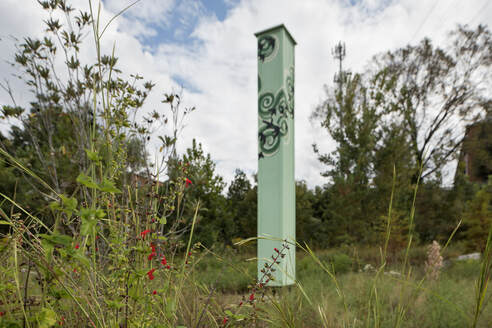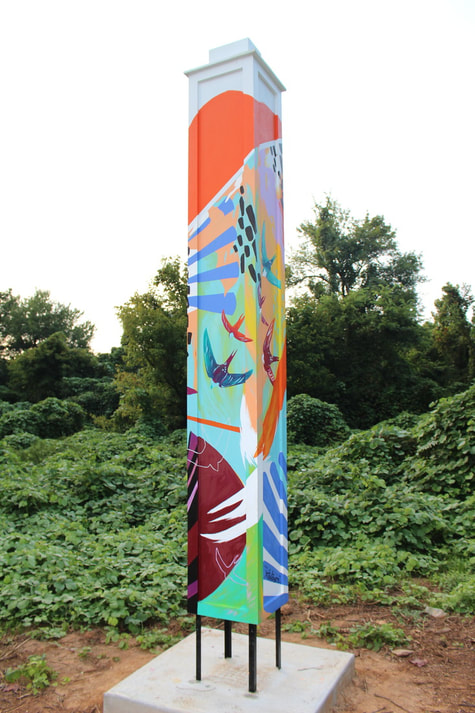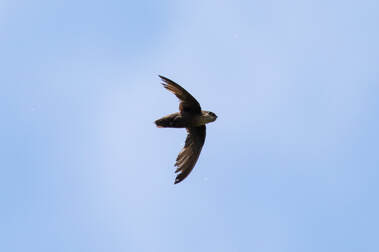Chimney Swift by Shawn Taylor
Chimney Swifts
 Atlanta Audubon is constructing Chimney Swift Towers, like this one in Piedmont Park, to provide nesting/roosting habitat for Chimney Swifts. Photo by Jessie Parks.
Atlanta Audubon is constructing Chimney Swift Towers, like this one in Piedmont Park, to provide nesting/roosting habitat for Chimney Swifts. Photo by Jessie Parks.
Birds Georgia chose the Chimney Swift as our focal species for 2019-2020. A cigar-shaped bird, Chimney Swifts spend the summer months in Georgia, and their high-pitched twittering is often heard overhead. Their aerial acrobatics may remind people of swallows, but Chimney Swifts are actually more closely related to Ruby-throated Hummingbirds. They have adapted to a life among humans, finding a home in chimneys after their preferred old-growth trees began disappearing.
The conservation status of the Chimney Swift was recently updated to Vulnerable on the International Union of Conservation of Nature (IUCN) Red List of Threatened Species. Stating that “In recent times, the number of available chimneys has decreased as a result of the demolition of old buildings, the capping of old chimneys, and through chimney sweeps removing nests from chimneys (despite the species being protected by federal law). Even though a scarcity of chimneys may not be limiting the numbers of Chimney Swifts yet, the rate of habitat loss is increasing and possibly developing into a severe threat.”
Still a fairly common sight in Georgia, Chimney Swifts are being forced to respond to additional threats across their range—from chimney capping, to tree removal, to a decreasing supply of insects due to pesticides, pollution, and climate change. Other issues, such as building collisions and challenges on swifts’ wintering grounds are exacerbating population declines.
Ultimately, the Chimney Swift is a bird connected to people. With their epic agility and stamina, their taste for biting insects, and their propensity for nesting in our chimneys during the summer months, Chimney Swifts and humans have a unique connection. We need to pitch in to ensure the continued health of this species.
The conservation status of the Chimney Swift was recently updated to Vulnerable on the International Union of Conservation of Nature (IUCN) Red List of Threatened Species. Stating that “In recent times, the number of available chimneys has decreased as a result of the demolition of old buildings, the capping of old chimneys, and through chimney sweeps removing nests from chimneys (despite the species being protected by federal law). Even though a scarcity of chimneys may not be limiting the numbers of Chimney Swifts yet, the rate of habitat loss is increasing and possibly developing into a severe threat.”
Still a fairly common sight in Georgia, Chimney Swifts are being forced to respond to additional threats across their range—from chimney capping, to tree removal, to a decreasing supply of insects due to pesticides, pollution, and climate change. Other issues, such as building collisions and challenges on swifts’ wintering grounds are exacerbating population declines.
Ultimately, the Chimney Swift is a bird connected to people. With their epic agility and stamina, their taste for biting insects, and their propensity for nesting in our chimneys during the summer months, Chimney Swifts and humans have a unique connection. We need to pitch in to ensure the continued health of this species.
HOW WE'RE HELPING
 Georgia Audubon recently worked with the Town Lake Community Alliance to install a Chimney Swift tower along the Noonday Creek Trail.
Georgia Audubon recently worked with the Town Lake Community Alliance to install a Chimney Swift tower along the Noonday Creek Trail.
Birds Georgia is supporting swift conservation by building Chimney Swift towers in the state, beginning with our first tower in Atlanta's Piedmont Park in 2018. Birds Georgia has installed towers at the following locations:
Chimney Swift towers mimic actual chimneys, serving as roosting and nesting habitat for the birds. Much like a real chimney, the central tower and interior walls provide nesting and roosting opportunities for these birds. Specially adapted claws allow the Chimney Swifts to cling to the inside of the tower, where they build saucer-shaped nests made out of twigs glued together with the birds' saliva. Chimney Swifts will not allow other birds (including other swifts) to use "their" tower while they are nesting, but in late summer, hundreds or event thousands of individual birds may roost in one large chimney, creating a spectacular site overhead as they flock into the chimney near dusk.
- Wrecking Barn Farm, in Loganville
- Henderson Park, in Tucker
- Sams Lake Bird Sanctuary, a Southern Conservation Trust property in Fayetteville
- Noonday Creek Trail, a collaborative project with the Town Lake Community Alliance.
- Freedom Park, through a DNR Wildlife Viewing Grant
- Two towers along the Atlanta BeltLine - one on Eastside and a second on the Westside Trail, through a grant from Patagonia Atlanta
Chimney Swift towers mimic actual chimneys, serving as roosting and nesting habitat for the birds. Much like a real chimney, the central tower and interior walls provide nesting and roosting opportunities for these birds. Specially adapted claws allow the Chimney Swifts to cling to the inside of the tower, where they build saucer-shaped nests made out of twigs glued together with the birds' saliva. Chimney Swifts will not allow other birds (including other swifts) to use "their" tower while they are nesting, but in late summer, hundreds or event thousands of individual birds may roost in one large chimney, creating a spectacular site overhead as they flock into the chimney near dusk.
how Can you Help
 Chimney Swift, by Shawn Taylor.
Chimney Swift, by Shawn Taylor.
Here are some ways you can help Chimney Swifts in your landscape:
- If your chimney is currently capped, consider uncapping it so that swifts can use it for nesting/roosting
- Leave dead trees standing if they don't endanger your house. Dead trees are the primary source of nesting sites for these birds and the removal of dead trees from our landscapes has contributed to the decline of this species.
- Don't spray for bugs. Chimney Swifts rely in flying insects, including mosquitoes, for food for themselves and for their young. Did you know one Chimney Swift can eat up to 1,000 mosquitoes per day? Spraying for mosquitoes and other insects eliminates this critical source of food for these birds. Even the pesticides touted as "bee and pollinator friendly" will harm the insect prey that birds depend upon.
- Sign up for Birds Georgia's Lights Out Program and commit to reducing/eliminating nighttime lighting during peak migration to help reduce bird/building collisions.
- Construct a tower! If you're interested in constructing a tower in your own landscape, Audubon North Carolina offers these tips.
- You can help Birds Georgia bring greater awareness to the plight of the Chimney Swift and implement conservation solutions to protect their habitat by making a donation to support our annual work.


